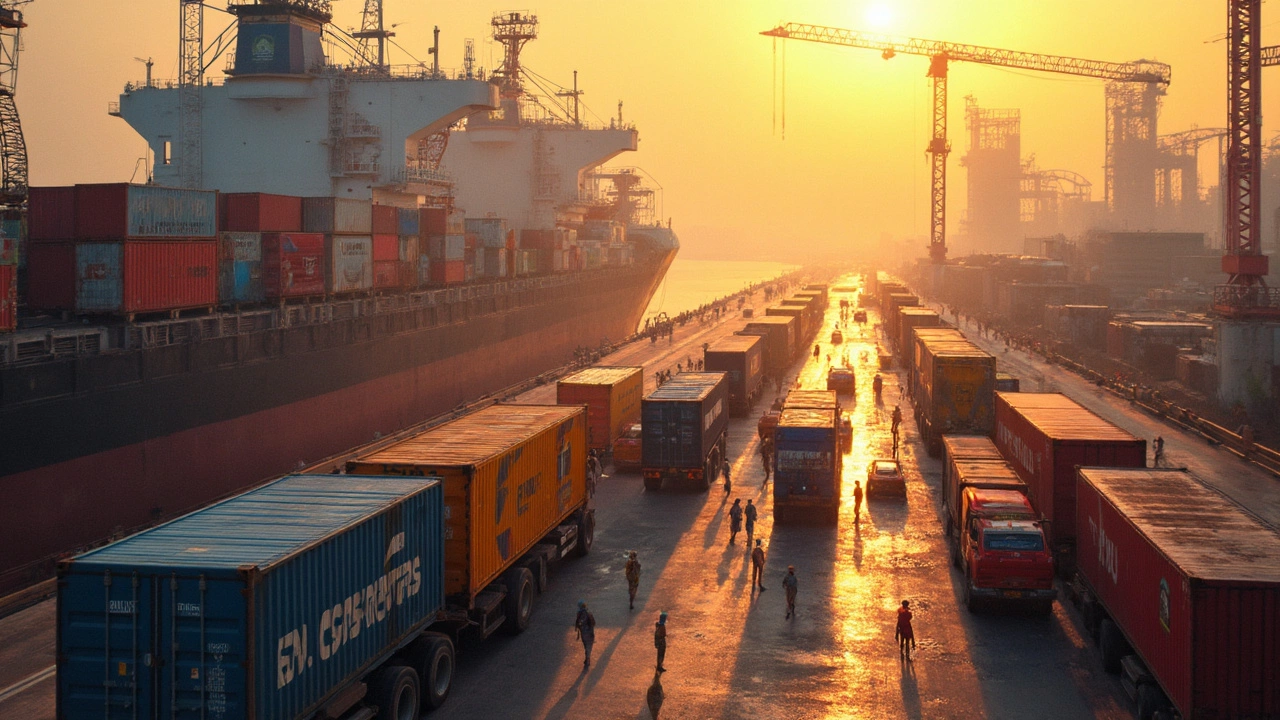 May, 2 2025
May, 2 2025
Walk into any major factory in Gujarat or Maharashtra and ask the managers about their biggest headaches. Chances are, one of the first things they'll mention is the cost and availability of imported chemicals. Even though India is climbing the ranks as a chemical manufacturing giant, it still depends heavily on other countries for some key substances—especially organic chemicals.
If you look at trade data for the past few years, the clear leader in imports is chemical compounds like ethylene, propylene, and especially specialty chemicals. But above all, India imports more organic chemicals than anything else in the sector. They're absolutely essential for making plastics, medicines, dyes, agrochemicals, and cleaning products. Without a steady stream of these, factories slow down or even stop.
- India’s Chemical Import Landscape
- The Most Imported Chemical: Why It Matters
- Where Imports Come From
- Tips for Chemical Buyers and Manufacturers
India’s Chemical Import Landscape
When people talk about chemical imports India is always in the spotlight. The country has a growing industrial base, but it still doesn’t make everything it needs. Even with huge chemical manufacturers in India, there’s a steady demand for reagents and raw materials from abroad. The main reason is simple: Many industries can’t get enough of the right type or quality chemicals locally, especially when it comes to advanced or specialty compounds.
Look at numbers from FY 2023, and you’ll see that India imported around $70 billion worth of chemicals. That’s not just perfumes and cleaners—it ranges from basic chemicals used in almost every factory, to high-end specialty ingredients needed for tech and pharma. Organic chemicals top the import list, making up about 40% of all chemical imports. Pharmaceutically significant chemicals like bulk drugs and intermediates follow close behind.
| Chemical Category | Share of Total Chemical Imports (%) |
|---|---|
| Organic Chemicals | 40 |
| Pharmaceutical Ingredients | 22 |
| Plastics & Resins | 16 |
| Specialty/Fine Chemicals | 14 |
| Others | 8 |
Why so much reliance on imports? A lot of it comes down to scale, technology, and resources. The cost of producing some chemicals at home is just too high, so Indian businesses look abroad for cheaper and better-quality options. It’s especially true for electronics, pharma, and agri-businesses that need pure, high-tech chemicals not always made locally.
Beyond just demand and supply, rules about quality and safety can also block local production. Even big chemical manufacturers sometimes find it easier to import particular intermediates than set up expensive new plants that also meet global standards.
The Most Imported Chemical: Why It Matters
If you want to know what chemical India brings in the most, it’s organic chemicals, and, within this, a huge chunk is ethylene and propylene derivatives. These are the building blocks for so much—think plastic products, packaging, pharmaceuticals, and even basic day-to-day items like cleaning supplies. Without them, the Indian chemical manufacturers sector would grind to a halt.
Here's a quick look at import numbers that might surprise you. In 2023, India imported over 9 million metric tons of organic chemicals, spending billions—some years, up to $29 billion just on this category. Why? Local production still can’t keep up with the crazy demand in manufacturing, pharma, agriculture, and consumer goods.
| Chemical | Approx. Import Volume (2023) | Main Uses |
|---|---|---|
| Ethylene Dichloride | 2.7 million tons | PVC, plastics |
| Propylene Derivatives | 1.3 million tons | Automobile parts, fibers |
| Phenol | 0.5 million tons | Resins, adhesives |
It matters because price changes or supply chain issues impact everything downstream. If the cost goes up, you’ll see it ripple into things like plastic pipes, electronics, or even the price tag at your neighborhood store. Plus, if factories need a specific compound like ethylene dichloride (EDC) and the shipment gets delayed, their whole production line waits. It’s that direct.
For a lot of chemical manufacturers India can’t yet produce certain specialty chemicals at scale. Maybe the technology isn’t there, maybe the cost is too high, or maybe the raw materials just aren’t available locally. That’s why India shops for these ingredients worldwide, especially from China, Saudi Arabia, and Singapore.
If you’re a buyer or manager in the industry, understanding what’s imported most isn’t just trivia. It helps you plan for pricing swings, shipping delays, or even checking if there’s an opportunity to source alternatives from new suppliers.

Where Imports Come From
If you check customs tallies, most chemical imports India relies on come from a handful of key countries. China is the king of the hill here—about 40% of India's imported chemicals arrive from there. China offers a combo of low prices, big volumes, and quick turnarounds that Indian companies can't ignore. It's mostly organic chemicals and specialty chemicals. If your business needs anything from API raw materials to dyes, chances are high they're from a Chinese plant.
Next up, the United States and some EU countries fill in the gaps. Germany, Belgium, and the Netherlands often supply high-end specialty chemicals and patented products, especially for pharma and electronics. The U.S. stands out for exporting advanced polymers, some medical ingredients, and other niche stuff Indian factories can't yet make in bulk.
Here's how India's chemical import sources broke down recently:
| Country | % Share (2023) | Key Chemicals Imported |
|---|---|---|
| China | 40% | Organic chemicals, dyes, APIs |
| USA | 10% | Polymers, specialty chemicals |
| Germany | 7% | Fine chemicals, pharma raw materials |
| Saudi Arabia | 6% | Petrochemical feedstocks, ethylene |
| Belgium & Netherlands | 5% | Specialty and agricultural chemicals |
Saudi Arabia and the United Arab Emirates are also important, especially for petrochemical raw materials. Their oil refineries churn out huge quantities of ethylene and propylene, which eventually end up in India’s plastics and packaging industries.
One thing that spooks Indian chemical manufacturers is the risk of putting too many eggs in China’s basket. Trade disputes or logistics snags can jack up prices overnight. That’s why more and more importers are trying to diversify—looking for deals in Southeast Asia, South Korea, and even inside Europe, just to avoid surprises if China shuts a key chemical factory for environmental checks.
Tips for Chemical Buyers and Manufacturers
Jumping into the buying or manufacturing game in the chemical manufacturers India space? Here are some practical, battle-tested tips to help you avoid common headaches and get the best deals, especially when dealing with heavily imported organic chemicals.
- Source smartly. Check if your suppliers are associated with accredited industry bodies such as the Indian Chemical Council (ICC) or have tie-ups with trusted global producers. Backdoor brokers might look cheaper, but quality or delivery reliability can mess up a whole production cycle.
- Keep an eye on exchange rates. Over 70% of India's organic chemical imports come from countries like China, USA, and Saudi Arabia. Exchange rate swings can nudge up your costs overnight. Many seasoned buyers lock in contracts when rates are favorable or hedge using futures.
- Compare landed cost, not just base price. Freight, insurance, duties, and GST can change the numbers fast. Some importers save up to 8% just by optimizing their shipping terms and customs paperwork.
- Monitor global supply trends. Post-pandemic, several manufacturers in China cut specialty chemical exports to India, causing delays and price jumps. Subscribe to reliable trade newsletters to get early warnings about shortages, regulatory changes, or shipping disruptions.
- Explore domestic alternatives. Indian producers are quickly ramping up local output of chemicals like caustic soda, acetic acid, and acrylic polymers. Sometimes, sourcing from Indian companies can cut your wait times—even if it costs a bit more upfront.
- Check REACH and BIS compliance. If you’re importing, your products must comply with BIS norms and international REACH standards. Non-compliance gets your shipment stuck at port, with extra storage charges or fines.
Here's a quick look at India's top sources for organic chemical imports last year:
| Country | Share of India's Organic Chemical Imports (%) |
|---|---|
| China | 37 |
| USA | 13 |
| Saudi Arabia | 10 |
| Singapore | 8 |
| Others | 32 |
In chemical manufacturers India circles, word travels fast. Talk with other buyers, attend trade shows, and keep relationships warm with more than one supplier. Flexibility is the secret weapon in managing chemical supply risks while keeping your business running smooth.